A few months ago, I thought Jhoira, Ageless Innovator could be a fun commander who would let me do cool things with Goblin Welder and Goblin Engineer, which are cards I enjoy playing. When I thought more about the deck, it became apparent pretty quickly it was going to be difficult to build a version of this deck which would play at a low enough power level for the average game of casual Commander. I tried my best to build a relatively tame version, with minimal interaction and no dedicated combo finish. I found pretty quickly that if Jhoira stays in play, it nets so much mana that no matter what you’re putting into play with it, the things you’re doing get out of hand pretty fast. I concluded it was inappropriate for me to play with Jhoira in casual EDH games, and if I wanted to keep playing with Jhoira, I had to bump it up to cEDH.

It occurs to me, as I’m about to get into a story, that, while it’s not pertinent to the topic of this article, I should probably acknowledge that I’m new here, but intend to be writing regularly. Lemme backpedal a bit and introduce myself for anyone new to my work.
Hi, I’m Sam Black. I’ve been playing Magic: The Gathering since 1994.
I’m old now, I guess, which is weird since I clearly remember being the kid at the game store when I showed up to my first tournaments in 1995. I have a theory that I’ve likely played more paper Magic than anyone else in the world. Bold claim? I guess so, and completely unverifiable, but, as I mentioned, I started playing early and never stopped. Most decisions I’ve made in my life have been made in pursuit of playing paper Magic as much as possible.
A lot of players know me from my time on the Pro Tour—I played in every Pro Tour from around 2009-2018 or something like that. I don’t think I was ever really that competitive, it’s just that if you wanted to play Magic more than your friends wanted to when I was a kid, or even an adult, the way you could do that was by playing in tournaments. Before EDH was invented, most stores didn’t really have much of a casual play scene. I played in tournaments but when I played with my friends, we’d play big deck multiplayer games years before EDH was a thing.
These days, it’s easy to go to a store and find games of commander, so I do that some nights. Other nights I host various Magic nights at my place, and on weekends I still usually play tournaments.
I really love Magic.
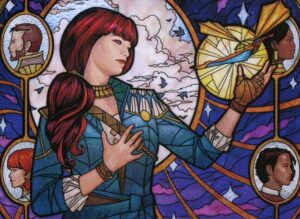
Jhoira, Ageless Innovator by Lisa Heidhoff
A Path to Commander
Before the pandemic, I was focused on professional play. I didn’t play casually much, and during the pandemic, I didn’t see people, and I wasn’t really interested in playing anything online that took more effort than drafting on Arena. Now that I can play in paper, and tournaments aren’t my whole career, I’ve been getting back into casual Magic. This brings me here, to this column, which will discuss my foray into all things Commander.
Right, so, with that out of the way, I was about to say I was in Philadelphia for the MagicCon when I decided I wanted to get a playable cEDH version of Jhoira together. While I was thinking about this, I happened to run into Rebell, a member of the CAG who’s pretty into cEDH. We’d spoken at a previous event and she seemed interested in discussing the format with me at some point, so I asked if she wanted to help me narrow down cards for a cEDH deck I was building. This isn’t super pertinent to the matter at hand, but I’m trying to offer a bit of the story here.
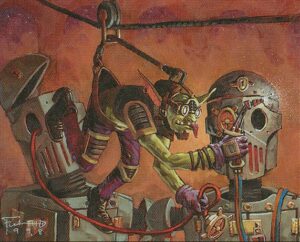
Goblin Welder by Scott M. Fischer
Anyway, we came up with a list, I proxied the handful of cards I didn’t have, and, after doing terribly in a sealed qualifier tournament, I found myself with some time to go to the Command Zone and try it out.
It played pretty well—I won four of the six pods I played in, and identified a few cards I didn’t need which I could easily cut. Since then, I’ve slowly thought of some other upgrades for it, slightly tweaking it over time.
So, how does one introduce a Commander deck? There sure are a lot of cards to talk about here, so let me try to bundle them as usefully as possible.
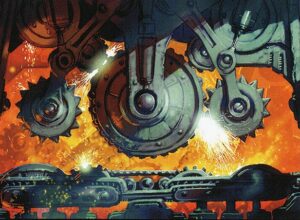
Grinding Station by Greg Staples
What We’re Doing Here
Let’s start at the end game because it’s often best to figure out where you’re trying to go and work backwards. This deck is generally trying to play a bit of a control game until it has the pieces to win with a Krark-Clan Ironworks combo.
To do that, you need Krark-Clan Ironworks, Scrap Trawler, Myr Retriever, and a few random hunks of metal. Which is to say, you technically haven’t won with only those three cards, but it’s extremely difficult to find those three cards without having also incidentally found enough other cards to draw your deck and make infinite mana.
If you’re not familiar, here’s how the combo works:
Have Krark-Clan Ironworks in play with Scrap Trawler and Myr Retriever. Declare any spell which costs mana. While you’re declaring the spell, you get a window to announce which mana sources you’re using to pay for it. During that window, announce you’re using KCI to generate four mana by sacrificing Myr Retriever and then Scrap Trawler—it doesn’t matter if you’re using any of the mana for the spell or not, you can make as much mana as you want during this step. This is important so you can make mana to pay for signets and stuff to get the mana to cast your spell.
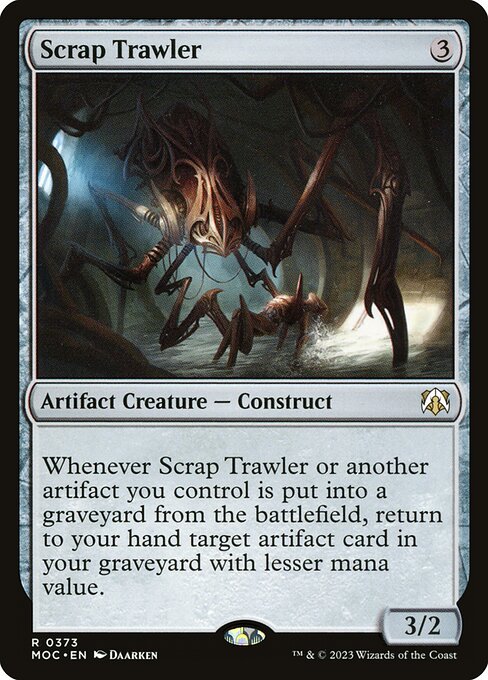
Scrap Trawler and Myr Retriever each have triggers when they die, but neither trigger can be placed on the stack until you finish announcing your spell. Because you sacrificed Myr Retriever first, it will also trigger your Scrap Trawler, and because you couldn’t put its trigger on the stack until you finished announcing this other spell, which is after you sacrificed Scrap Trawler. Scrap Trawler will be in the graveyard when you choose your target for Myr Retriever. This means Scrap Trawler’s trigger can return Myr Retriever to your hand and Myr Retriever’s trigger can return Scrap Trawler, but you also have an extra trigger from Scrap Trawler from when the Myr Retriever died, which allows you to return another one or zero mana artifact. Scrap Trawler and Myr Retriever cost five mana and give you four mana, so you can use this loop to spend one mana to return a one or zero mana cost artifact from your graveyard to your hand.
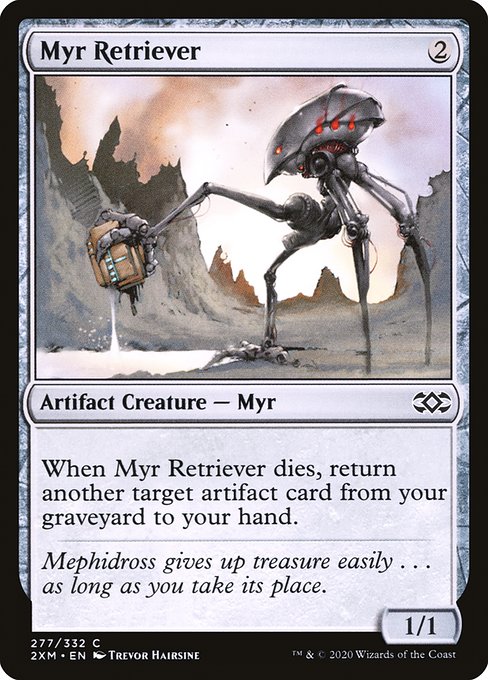
With KCI, a one mana artifact can be sacrificed for two mana, so whatever it is, you can play it and sacrifice it and now you’re mana neutral on your loop. If you also have a zero mana artifact, you can perform that loop while Scrap Trawler’s on the battlefield, allowing you to pick up the zero mana artifact also, so now you can play and sacrifice the zero mana artifact each time you perform this loop, and now you’re plus two mana each time. If you have an artifact that costs zero instead of one, you’re mana positive, except you’ll run out of spells you can use to generate a window to sacrifice both creatures at the same time. That step only happens when you cast a card that costs mana, so you mostly need a one cost artifact and a zero cost artifact, but if the one is Arcum’s Astrolabe or Chromatic Star, you get to draw until you find a zero.
If you add Spine of Ish-Sah to the mix you get to kill any permanents you want, and also cast every artifact in your graveyard that costs less than seven as many times as you want.

Jhoira, Ageless Innovator by Justyna Dura
The Core Components
So, as for the decklist, combo pieces:
KCI and Scrap Trawler are a lot better if you have some random cantrip artifacts in your deck. These cards also make tools like Goblin Welder, Goblin Engineer, and Emry, Lurker of the Loch good, so the deck wants some cantrip artifacts. There are around 20 artifacts you could reasonably play in this space, but you don’t need that many, so I’m only playing what I consider the best available:
Elsewhere Flask is preferable to other similar artifacts because of its ability to freely sacrifice itself, which is good with Scrap Trawler or Emry, Lurker of the Loch. It can also turn off a Carpet of Flowers for a turn or fix your mana once.
There are a few other infinite combos in the deck. The reason I say “all roads lead to KCI” is that I’ve avoided playing any dedicated finisher cards like Thassa’s Oracle or Altar of the Brood by including the four-card KCI package. Any of my other infinite combos can eventually find that to win the game.
If you have Emry with Mirran Spy you can untap Emry whenever you cast an artifact and tap Emry to cast the artifact again. If you have Lotus Petal, you can make infinite mana, and then if you have any artifact that can sacrifice itself to draw a card, you can draw your deck. If you have Urza’s or Mishra’s Bauble, you can draw as many cards as you want during the next upkeep.
If you have Grinding Station and Underworld Breach with any zero mana artifact you can mill your deck. If that zero mana artifact taps for mana, you can make a bunch of mana while you do this, the details can get a bit weird, but this wins in almost any situation if left unchecked.
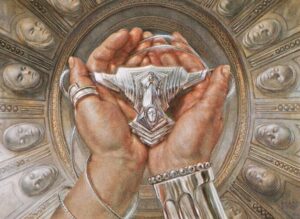
Chrome Mox by Volkan Baǵa
It’s All About The Process
So that’s the end game. Now how do we get there?
Jhoira is an incredible Commander because it allows you to play artifacts at instant speed without spending mana and without showing your opponents what they are before they’re on the battlefield. This also makes them uncounterable, and gets around a wide range of cards people (including you) play to make casting spells harder.
This deck is designed to take full advantage of Jhoira.
To start with, we’d really like to play Jhoira on the first turn if possible, so we want some cards to let that happen:
I’m currently not playing Simian Spirit Guide because it has no other synergies and is generally a really bad draw after your opening hand, but I’m not sure not playing it is right.
Once Jhoira’s on the battlefield, things get explosive if you can untap it additional times to build up counters, and put bigger artifacts onto the battlefield for free:
There are more cards which let you untap creatures, of course, but again, I think these are the best ones.
Now, given this artifact toolbox I’m going to want in my deck, I want some other creatures that really take advantage of that setup:
All of these are also incredible with Thousand-Year Elixir and do tons of awesome things in the deck.
I’m a toolbox/combo deck, so I want some other strong tutors:
Next up I’d like some card advantage, just basic Magic stuff:
- Mystic Remora
- Rhystic Study
- Memory Jar
- The Mightstone and Weakstone
- Coveted Jewel
- Paradoxical Outcome
- Sandstone Oracle
It’s a bit of an unusual card draw package, but using artifacts is so good for me where possible. I’m on the fence on Mind’s Eye.
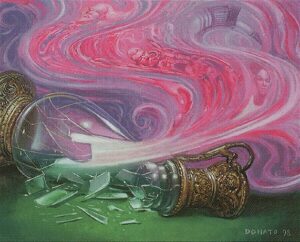
Memory Jar by Donato Giancola
Next, and this is a big one, disruption. I need to stop my opponents from winning first, because I’m not actually the fastest cEDH deck:
- Aether Spellbomb
- Damping Sphere
- Ensnaring Bridge
- Trinisphere
- God-Pharaoh’s Statue
- Knowledge Pool
- Ward of Bones
- Portal to Phyrexia
- Soulless Jailer
- Spellskite
- Fierce Guardianship
- Force of Will
- Hydroblast
- Lightning Bolt
- Pyroblast
- Red Elemental Blast
- Cyclonic Rift
- Mana Drain
- Deflecting Swat
- Mindbreak Trap
- Karn, the Great Creator
This is the part of the deck that’s most flexible, especially the non-artifact spells. There are a lot of good options and I’m very much unsure that all the cards I’m playing are better than other options like Mental Misstep, Force of Negation, Arcane Denial, An Offer You Can’t Refuse, Abrade, etc. I could also be playing different artifacts like Sphere of Resistance. These cards aren’t essential to how the deck functions, they’re just for stopping other people, so which cards are best really just depends on what you expect.
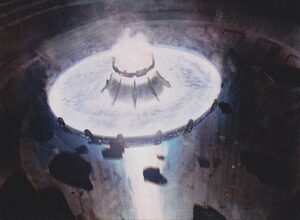
Knowledge Pool by Mike Bierek
Knowledge Pool is worth calling out as it’s a weird card to include, as it’s usually used as a hard lock with something like Teferi, Time Raveler or Arcane Laboratory, and I’m not playing anything like that. The closest I have is Soulless Jailer, which still allows creatures to be cast from the Knowledge Pool. However, because I don’t have to spend mana to play it, if I put it into play on my turn, I can get first crack at taking the best cards from it, and because my opponents won’t know it’s coming when I tap Jhoira, I can put it onto the battlefield in the middle of someone else trying to execute a combo and it’s very unlikely they’ll be able to finish pulling it off. Once it’s in play, I can use Jhoira to play my artifacts without going through the Knowledge Pool.
Next up, a bit of busted mana generators that don’t typically help cast Jhoira, but do help with other spells enough to be worth it:
- Ragavan, Nimble Pilferer
- Dockside Extortionist
- Mana Crypt
- Mox Amber
- Mox Opal
- Sol Ring
- Imposter Mech
- Phyrexian Metamorph
I included Imposter Mech and Phyrexian Metamorph in this section due to their high probability of copying Dockside Extortionist.
Last, a couple oddballs, and then lands:
Panharmonicon is a strong artifact with everything I have going on here. Ugin’s Nexus is theoretically disruption, but I’ve never left it in play to stop someone else from taking another turn, it’s just a Timewalk I can play by tapping my commander if I have KCI, a Goblin, or Kuldotha Forgemaster. It gets wild with Karn, the Great Creator—it’s not infinite turns, but it’s enough that it’s hard to imagine not winning from there.
The Deck List
Putting all that together with some lands, we come to the full list:
Commander (1)
Jhoira, Ageless InnovatorCreature (15)
- Dockside Extortionist
- Emry, Lurker of the Loch
- Goblin Engineer
- Goblin Welder
- Imposter Mech
- Kuldotha Forgemaster
- Master Transmuter
- Mirran Spy
- Myr Retriever
- Phyrexian Metamorph
- Ragavan, Nimble Pilferer
- Sandstone Oracle
- Scrap Trawler
- Soulless Jailer
- Spellskite
Instant (15)
- Cerulean Wisps
- Cyclonic Rift
- Deflecting Swat
- Fierce Guardianship
- Force of Will
- Hydroblast
- Lightning Bolt
- Mana Drain
- Mindbreak Trap
- Muddle the Mixture
- Paradoxical Outcome
- Pyroblast
- Red Elemental Blast
- Shore Up
- Whir of Invention
Sorcery (2)
Artifact (34)
- Aether Spellbomb
- Arcum’s Astrolabe
- Chromatic Star
- Chrome Mox
- Citanul Flute
- Coveted Jewel
- Damping Sphere
- Elsewhere Flask
- Engineered Explosives
- Ensnaring Bridge
- God-Pharaoh’s Statue
- Grinding Station
- Ichor Wellspring
- Jeweled Lotus
- Knowledge Pool
- Krark-Clan Ironworks
- Lotus Petal
- Magewright’s Stone
- Mana Crypt
- Memory Jar
- Mishra’s Bauble
- Mox Amber
- Mox Diamond
- Mox Opal
- Panharmonicon
- Portal to Phyrexia
- Sol Ring
- Spine of Ish Sah
- The Mightstone and Weakstone
- Thousand-Year Elixir
- Trinisphere
- Ugin’s Nexus
- Urza’s Bauble
- Ward of Bones
Enchantment (3)
Planeswalker (1)
Land (29)
- Cascade Bluffs
- Command Tower
- Flooded Strand
- Gemstone Caverns
- Inventors’ Fair
- Minamo, School at Water’s Edge
- Misty Rainforest
- Mystic Sanctuary
- Otawara, Soaring City
- Polluted Delta
- Scalding Tarn
- Shivan Reef
- 6 Snow-Covered Island
- 5 Snow-Covered Mountain
- Spirebluff Canal
- Steam Vents
- Sulfur Falls
- The Mycosynth Gardens
- Training Center
- Volcanic Island
And that’s the deck. I’ve had a blast playing it, and I’ve made finding chances to do so a priority lately.
While I do have at least one other cEDH deck I’m interested in exploring in the near future, I want to note that this column will focus on my experiences with casual play, and will not exclusively cover cEDH. I have a long history of writing about Magic in a particular way and for a particular audience, and I’m looking forward to finding the right tone and content for this new space.
Sam Black (any) is a former professional Magic player, longtime Magic writer, host of the Drafting Archetypes podcast, and Twitch streamer. Sam is also a Commander Cube enthusiast, and you can find Sam’s cube list here. For anything else, find Sam on Twitter: @SamuelHBlack.

